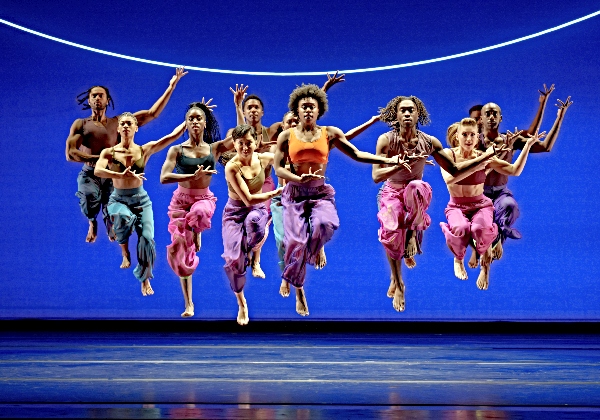
In the first of their recently agreed-upon four-year residency project at the Music Center’s Dorothy Chandler Pavilion, the Alvin Ailey American Dance Theater brought two different programs to the stage for seven performances.
This writer was able to attend one of these events that are part of the visiting company’s 65th anniversary season. Interestingly, sandwiching the recently created choreography by former Ailey dancer Jamar Roberts, “Ode,” the first and closing pieces demonstrate some of the cultural changes that have occurred between the premiere dates of the two works.
Choreographed by 2013 MacArthur Genius awardee Kyle Abraham, “Are You in Your Feelings?” (2022) incorporates movement and a “mixtape” of songs and conversations that are drawn from the creator’s own personal history, as well as from an African-American experience.
On the dance end, there is a very interesting connection between the European/American contemporary style and the creator’s idiosyncratic use of body isolations, small movements, gesture, rhythm and sense of gravity. Surprisingly, live voices speak, shout and exclaim around the short musical R&B tunes, electronically manipulated episodes and other sound environments. The resulting palette demonstrates a picture of relationships — whole group, gender-specific (just the men or just the women), hetero- and same sex pairings and solos.
Often, repertory companies like AAADT do their best at interpreting the dancemaker’s physical vocabulary. Having to wrestle with choreographers from many different modern dance backgrounds, some styles show up better than others. This company does a great job with Abraham’s designs. Given the scenario within which this piece is situated, African-American relationships, the streetwear-like costumes by Karen Young clothe the women in sports bras and leotard-type tops, the men shirtless, and everyone wearing loose and blousy pants. This helps to make this a dance of the 21st century.
On the other hand, and to the great credit of founder Alvin Ailey’s own signature masterpiece, “Revelations,” this exuberant series of dances can be looked at as a summary of the African-American experience up to its premiere in 1960. From an endowment that mandates that the revised 36-minute classic be presented in each performance, audiences repeatedly revel at the virtuosic dancing, the spiritual, gospel and blues music, the culturally familiar wardrobe (by Ves Harper and Barbara Forbes) and the messages in the music.
Viewers can be seen and heard “Wow!”-ing at the performers’ high leg extensions, multiple fast turns and heroic partnering sculptures. As the piece is presented at every show, returning crowds know when and how to clap with the beat, when to stop and what comes next. Sectional titles include “Pilgrim of Sorrow,” “Take Me to the Water” and “Move Members Move.” This writer’s personal highlight is the ocean blue cloth that extends across the stage to symbolize water as it floats up and down and the dancers move in and around it. “Revelations” has been said to be a transformative experience for some theatergoers and a terrific finale to the occasion.
In between the two described pieces, “Ode” has a tough act to follow and precede. Created in 2019 by Jamar Roberts, the sextet for women takes place below a large print-like design created by Libby Stadstad. Accompanied by a prerecorded soft jazz piano score composed and played by Don Pullen, the onstage group creates a community. The females wear dresses, grayish at the bottom and lighter at the top, designed by the choreographer that turn beautifully and tighten along the dancers’ torsos. The movers often act in unison in a gentle way. Toward the end of the work, one of the women is cradled and tenderly laid on the floor. Promotional information tells us that the piece is “a meditation on the beauty and fragility of life in a time of growing gun violence.” Again, another look into the American Black experience.
—Benn Widdey, Culture Spot LA





